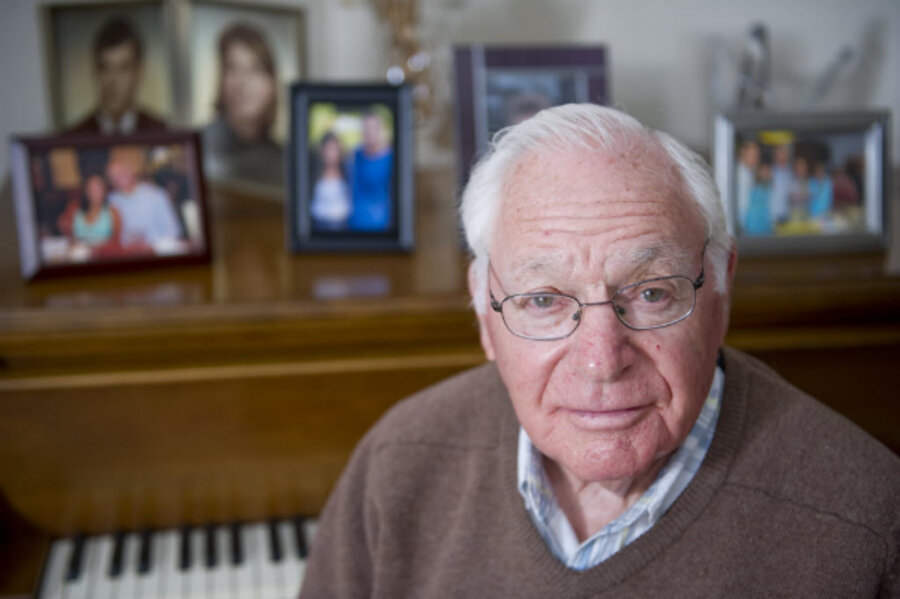Immigration and assimiliation: Immigrant roots, but made in America
| Worcester, Mass.
Back when he was a boy, Manuel Weintraub's world revolved around Water Street, the spine of Jewish life here, where newcomers from Russia, Latvia, Austria, and Lithuania would go to shop, chat, and hear the latest gossip. They might stop at one of three bakeries or three kosher butchers, or drop by for a pastrami sandwich at the deli started by his parents, Sam and Ida.
"It was a place you would go to be with your own," recalls Mr. Weintraub, who started working at the deli as soon as he could clear a table and for most of the next 50 years spent 12- to 15-hour days making sandwiches, slicing corned beef, and schmoozing. The world of Jewish immigrants moved past his windows and poured into the 14 vinyl booths.
It's different now, though, as it is for many of Weintraub's generation. About 20 percent of the country's 20 million adult second-generation immigrants, the term for American children with at least one foreign-born parent, are 65 or older, according to the Pew Research Center's analysis of US Census data. Most are descendants of people like Sam and Ida Weintraub, who came to this country in what is called the "second wave" of immigration to the United States.
Although these second-generation immigrants might maintain an ethnic identity – Italian, German, Jewish – they are, by many measures, fully assimilated, dispersing into previously Anglo communities and filling all varieties of professional jobs; their children are even more likely to marry outside their ethnic group and speak English rather than the tongue of the old country.
These children of immigrants may have changed US society with them – think spaghetti and meatballs or pastrami on rye – but for themselves, there's no question: They're American.
"We have this phenomenon in the United States where we have hyphenated identities. You can retain a cultural identity and still be an assimilated person," says Jacob Vigdor, public policy expert at Duke University in Durham, N.C., who created an "assimilation index" to gauge immigrant integration. "Your ethnicity and national identity are not wrapped up together. If you were to describe yourself as a Chinese-American, nobody would bat an eye. You can think of yourself as American, as in that's the country to which you belong, and also think of yourself as a member of an ethnic group."
To have a sense, then, of how today's immigrant families might integrate into, and change, US culture, it's instructive to look at families such as Weintraub's. Sam and Ida fled a Europe of pogroms and economic struggle. Coming from Austria and Lithuania, they were thrilled to be in the US. Whenever Manuel tired of washing tables or ached from slicing meat and making sandwiches, his parents were quick to remind him how good he had it.
"They always looked back at the old country as a horrible place," he recalls. "And here – this was opportunity."
They moved to Worcester for the reason so many Jews settled here, he says. There was always, it seemed, a cousin, or an uncle, or a distant friend of the family who promised a town full of synagogue-going neighbors and factory bosses who wouldn't require work on Saturday, the Jewish sabbath. Sam came to join his cousins who ran a deli; then he opened his own.
Sam and Ida quickly learned English. They were businesspeople, after all, and they wanted to be able to chat with anyone who sidled up for a bowl of matzo ball soup. They spoke Yiddish at home, though. Especially when they didn't want the kids to understand what they were saying.
Manuel's world was all in English. He had Jewish friends, but went to school with children from across the city, and he got along with everyone. In World War II, as the only Jew and New Englander in an otherwise entirely Southern Army unit, he had to prove that he wasn't going to be pushed around. But he never felt anything but American. "We were all there together fighting for our country," he says.
Today, nearing 90, Weintraub wields a golf club instead of a carving knife. It has been decades since he and his brothers sold the deli, decades since he moved across town to Worcester's leafier West Side – something unthinkable for his parents. ("If you were Jewish, you lived on the East Side," he says.)
From the comfortable condo he shares with his wife, Clara, Weintraub worries not about questions of identity, or assimilation, but about whether or not to sell the Florida condo (they did), or how the grandkids are doing (he has two), or if the golf handicap will go down (he's doubtful).
As for Water Street, the Jewish enclave all but disappeared by the 1970s, when Interstate 290 was built through the neighborhood.
Weintraub's Jewish Deli is still there, albeit without any Weintraubs. It has kept the old sign and decor, now considered "vintage," and dishes out matzo ball soup and Hebrew Nationals to customers who come as much for the kitsch as for the food.
Next door is the new Olé Taqueria.





